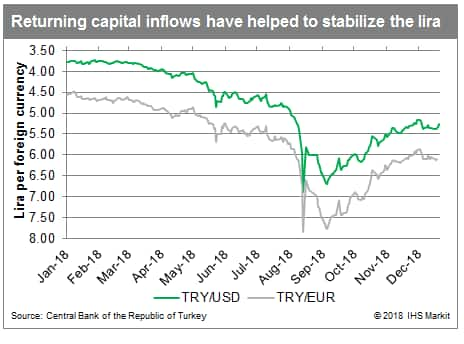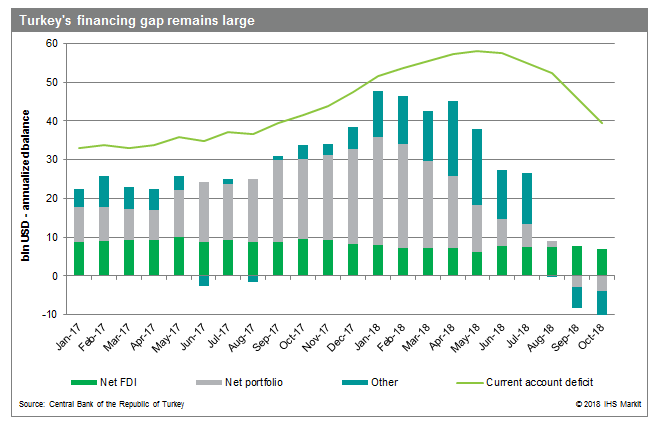Capital inflows have returned to Turkey, but remain precarious
- In October, Turkey attracted a net inflow of portfolio investment for the first time since January. The net inflows are a key inflection point that show a slow return of investor sentiment.
- In recent months, Turkey has also enjoyed success in international financial markets (albeit at higher costs) and the lira has re-appreciated.
- This stabilization and return of capital investment inflows remain tenuous, however, international investor confidence in the country remain low.
- Even with a modest return of capital investment inflows and a sharp narrowing of the current-account deficit, the external financing gap remains dangerously large.
In October 2018, Turkey attracted a net inflow of portfolio
capital for the first time since January. Although the net inflow
was modest - just USD491 million - it nonetheless represents a key,
potential inflection point after the country lost a total of
USD8.702 billion in net portfolio outflows from February-September
2018. The strong shift of global sentiment towards developed
markets, combined with self-aggravated lack of investor confidence
in Turkish economic policy-making sent portfolio investment rushing
out of the country during most of 2018. After a sharp hike to
interest rates, a tightening of monetary policy, and promises of
stabilization measures - including scaling back fiscal stimulus -
has helped to recapture capital inflows.  The return of capital inflows
helped to buoy the value of the lira. From 24 September to
end-October, the lira regained 12% of its value against the US
dollar. Continued lira gains in November suggest that portfolio
investment remained inward on a net basis that month. By 3
December, the lira had reached 5.162 per US dollar, nearly 18%
stronger than it had been as of late September. So far in December,
the lira has fallen back somewhat, likely in anticipation that the
Central Bank of the Republic of Turkey (TCMB) would decline to
raise interest rates at its 13 December meeting. With the TCMB
following through on expectations and keeping interest rates
unchanged, the lira has remained stable, at a slightly weaker
level, in the week since.
The return of capital inflows
helped to buoy the value of the lira. From 24 September to
end-October, the lira regained 12% of its value against the US
dollar. Continued lira gains in November suggest that portfolio
investment remained inward on a net basis that month. By 3
December, the lira had reached 5.162 per US dollar, nearly 18%
stronger than it had been as of late September. So far in December,
the lira has fallen back somewhat, likely in anticipation that the
Central Bank of the Republic of Turkey (TCMB) would decline to
raise interest rates at its 13 December meeting. With the TCMB
following through on expectations and keeping interest rates
unchanged, the lira has remained stable, at a slightly weaker
level, in the week since.
Improving net inflows of capital have gone hand-in-hand with the country's recent success in the international capital markets. Banks have been increasing their capital buffers, attracting willing partners. Banks have also been successful in rolling over their external debt obligations, albeit at elevated costs. Sovereign debt sales have been well subscribed, raising USD7.7 billion in 2018 as a whole, nearly half of which within the last month. Bond spreads - having soared in August-September - have re-narrowed significantly in October-December.
Meanwhile, the current account balance has turned around. Turkey
posted a current-account surplus for the third consecutive month in
October. Depressed domestic demand due to weaker buying power,
higher interest rates, and lack of business confidence have
severely curtailed imports. In the period August-October 2018,
total merchandise imports plunged by 21.2% year on year (y/y).
Service imports have also dropped sharply in recent months, down by
11.3% y/y in the most recently reported three months. The strong
y/y improvements since August have finally pushed the cumulative
current-account deficit below what it had been a year earlier.  Even with the rapid turnaround
of the current-account balance - we are now forecasting a
current-account deficit of only around 2.5% of GDP in 2019 as a
whole -- and the return of net inflows of portfolio investment,
Turkey has substantial external vulnerability. On an annualized
basis, the financing gap between net capital inflows and
current-account deficits is yawning. The financing gap must be met
through a combination of errors and omissions, new borrowing and
drawing down what are already depleted reserves. By end-October,
total foreign currency reserves were more than USD20 billion down
from where they had been at the end of 2017, covering only 3.8
months of imports.
Even with the rapid turnaround
of the current-account balance - we are now forecasting a
current-account deficit of only around 2.5% of GDP in 2019 as a
whole -- and the return of net inflows of portfolio investment,
Turkey has substantial external vulnerability. On an annualized
basis, the financing gap between net capital inflows and
current-account deficits is yawning. The financing gap must be met
through a combination of errors and omissions, new borrowing and
drawing down what are already depleted reserves. By end-October,
total foreign currency reserves were more than USD20 billion down
from where they had been at the end of 2017, covering only 3.8
months of imports.
While the return of capital inflows in October may be an inflection point, with modest net inflows expected to continue throughout 2019, downside risks to overall stability remain substantial. Given a low level of international confidence in the country's economic policy-making, another crisis could once again trigger instability. The just-announced US withdrawal from Syria that may reignite regional violence; a major US fine against the Turkish banking sector; and the Iranian sanctions are all potential triggers. Of greatest concern, though, is with the country on the verge of a recession, President Erdoǧan may be tempted to abandon stabilization policies in pursuit of stimulating growth, launching another crisis. As the US Fed continues to raise its rates and the TCMB holds its rates unchanged (or begins to lower them at the direction of Erdoǧan), the potential for destabilization increases.
